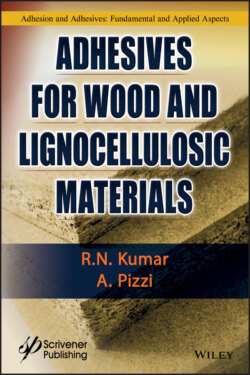Читать книгу Adhesives for Wood and Lignocellulosic Materials - R. N. Kumar - Страница 28
1.5 Influence of Hierarchical Structure of Wood on Wood–Adhesive Interaction
ОглавлениеMarra [27] describes the process of adhesive bond formation in a wood substrate by five steps: flow, transfer, penetration, wetting, and solidification. The flow involves the spreading of the liquid on the wood surface. This is followed by transfer of adhesive to the adjacent wood surface. Capillary forces within the cell lumens promote penetration, and bulk flow occurs due to applied pressure. Wetting of the wood surface by the adhesive occurs to an optimum extent, which promotes the molecular contact between the adhesive and wood surface. Finally, solidification occurs as a result of the formation of three-dimensional cross-linked structure when the glue line is exposed to high temperature.
Penetration of adhesive into the porous network of wood cells is believed to have a strong influence on bond strength [28–30].
Damaged wood cells may be reinforced by the adhesive, and stresses may be more effectively distributed within a larger interphase region. The optimum depth of penetration is required to ensure mechanical adhesion [31], but excessive penetration causes insufficient adhesive remaining at the interface [27], leading to a starved bondline. This constitutes a weak boundary layer and a weak spot in the chain (see Figure 2.7) of Marra’s chain-link analogy [27] (see Section 2.15). This analogy emphasizes the fact that the overall strength of an adhesive bond in a composite is determined by the weakest portion of the chain. In other words, an adhesive bond is just as good as the weakest link in the chain. In this respect, adhesive penetration plays a vital role in this analogy.
